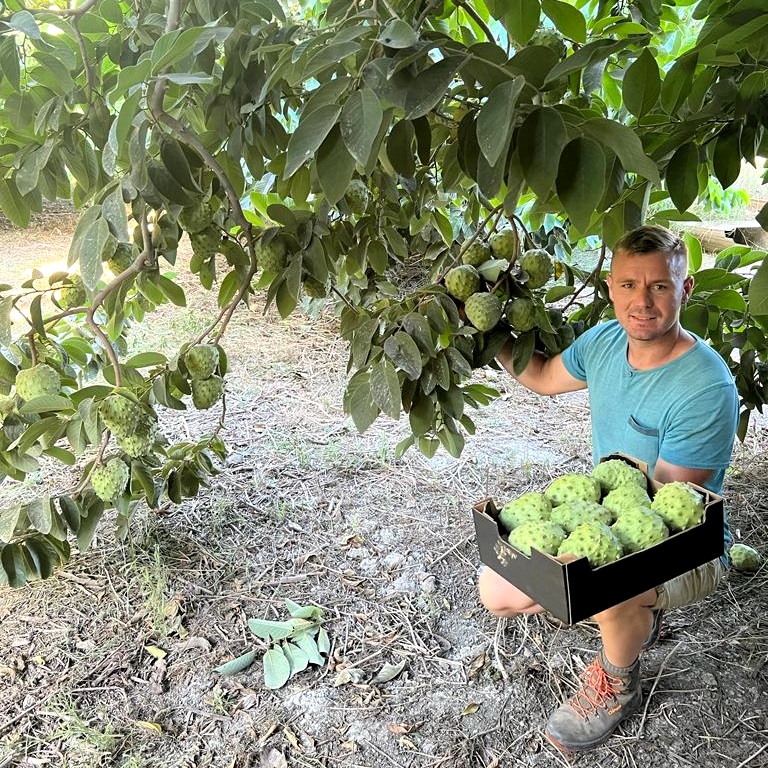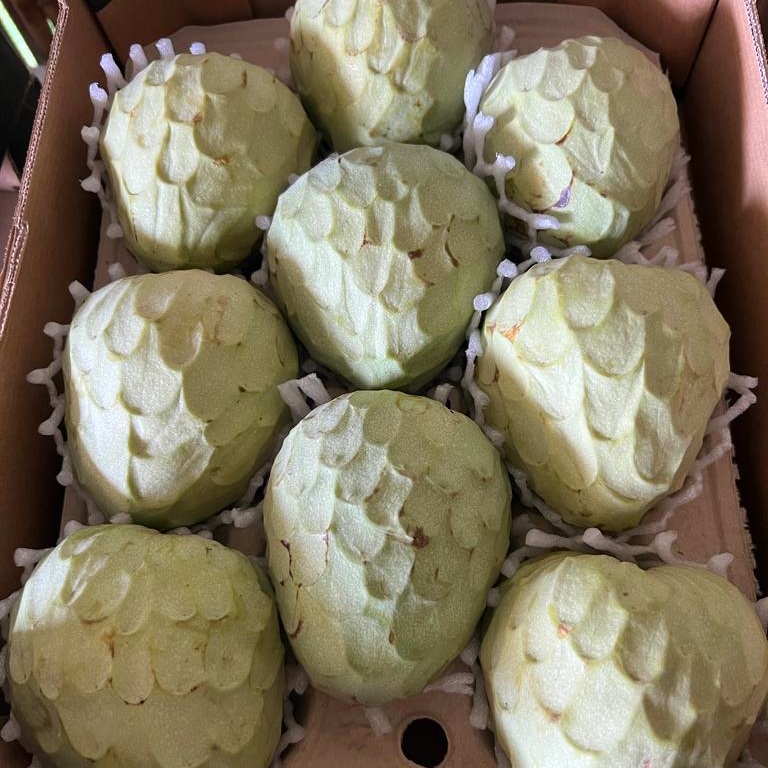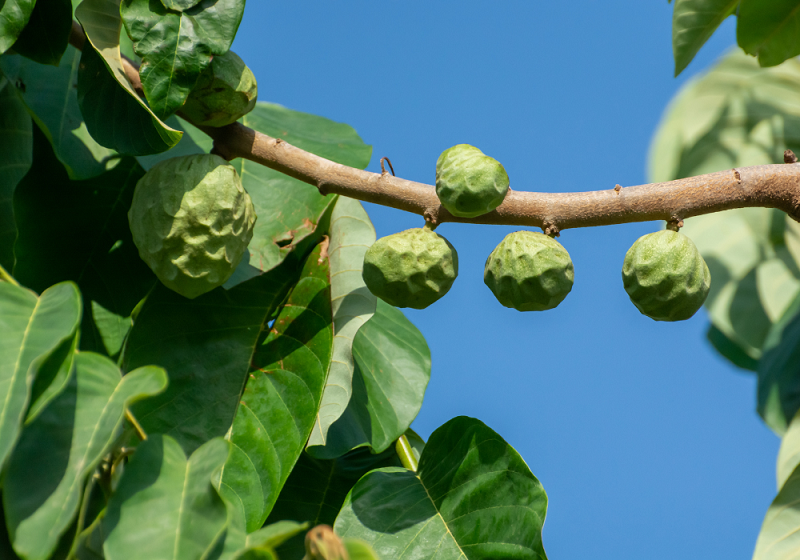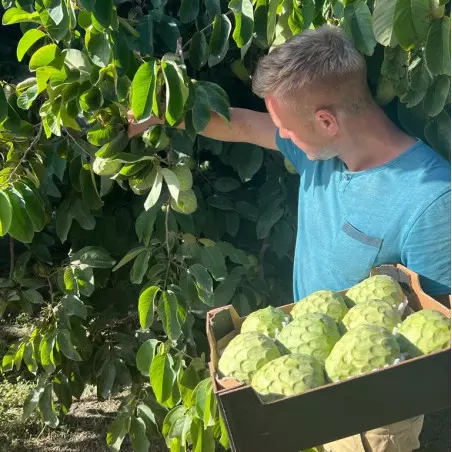The cherimoya It is an exotic fruit with astonishing appearances, very rare and little known to the general public. This fruit with an exceptional taste hides many secrets and unsuspected benefits. You may hear some people call it: Cherimole, Annona cherimola, Anone, Chirimoya, or Churimoya. It originates from distant lands and has been appreciated for centuries in certain tropical regions of the globe. And for cooking enthusiasts, this tropical marvel always amazes chefs and especially pastry chefs with the flavor it brings to their various recipes.
In this article, let's explore the cherimoya, its origin, its sweet flavor, its nutritional benefits, and its numerous health virtues.
Where does the cherimoya come from ?
The Annona cherimola, or cherimoya for simplicity, originates from South America, specifically the mountainous regions of the Andes. Its cradle is primarily in countries such as Peru, Colombia, Ecuador, and Bolivia. Its name "Chirimoya" is derived from the Quechua dialect which means "cold seeds", because these seeds can grow at high altitudes despite the very low temperatures.
Over time, the cultivation of cherimoya has spread to other tropical regions of the globe such as Southeast Asia and certain Pacific islands, in Europe where it can be found in Portugal and Spain, and also in the United States, specifically in California.
What are the nutritional values of cherimoya ?
Here is an estimate of the main nutritional components for 100 grams of cherimoya:
- Calories: approximately 75 kcal
- Carbohydrates: approximately 17 grams
- Of which sugars: approximately 14 grams
- Lipids: approximately 0.2 grams
- Proteins: approximately 1.5 grams
- Fibers: approximately 2 grams
- Vitamin C: approximately 18.3 mg (approximately 30% of the recommended daily intake)
- Vitamin B6: approximately 0.257 mg (approximately 13% of the recommended daily intake)
- Vitamin B2 (Riboflavin): approximately 0.13 mg (approximately 8% of the recommended daily intake)
- Potassium: approximately 270 mg (approximately 8% of the recommended daily intake)
- Magnesium: approximately 21 mg (about 5% of the recommended daily intake)

What is the growing season for cherimoya ?
"In the kingdom of fruits, patience is queen." Indeed, patience is very important in fruit cultivation, as it can take time before fruit trees produce abundant harvests.
For cherimoya, the growing season in its country of origin, which is South America, generally extends from September to April. These months correspond to the harvest period and the peak availability of this exotic fruit in these regions. This period may vary slightly depending on geographical areas such as Southeast Asia and the Pacific Islands due to climatic variations.
At Biovie, we offer the cherimoya Of Spanish variety, it is organically grown in the south of Spain. Available in 4-kilogram boxes, with cushioning made from recycled cardboard.
What are the benefits of cherimoya ?
If you know the number of benefits this fruit contains, you won't be able to do without it anymore! There are so many that we can't list them all, here are a few examples:
Good source of vitamins, minerals, and antioxidants: Cherimoya is rich in vitamins B6 and B2, which contribute to the proper functioning of the nervous system, as well as minerals such as potassium and magnesium, and other essential nutrients. Vitamin C is also present in this fruit (though not in the same quantity as in oranges, which still hold the top spot); it acts as an antioxidant that helps neutralize free radicals in the body.
Rich in fiber: Who "Say fibers, say good digestion. Cherimoya contributes to regular bowel movements, so you can say goodbye to constipation because this fruit promotes good intestinal health."
Cardiovascular support: Thanks to the potassium present in cherimoya, it can help maintain healthy blood pressure, which may reduce the risk of cardiovascular diseases.
Low in fat: Cherimoya is naturally low in fat, making this fruit an excellent food for people looking to reduce the fat in their diet. Additionally, it provides a satisfying effect and a feeling of fullness.
Anti-inflammatory properties: Some preliminary studies have suggested that cherimoya extracts might have anti-inflammatory properties, thanks to the presence of certain phytochemical compounds, such as flavonoids and acetogenins. These phytochemical compounds can inhibit the activity of certain pro-inflammatory enzymes and inflammatory mediators, which could help reduce inflammation in the body.
Good source of calcium: Cherimoya contains calcium, an essential mineral for the health of bones and teeth. Although the amount of calcium is not as high as in dairy products, it is considered a good food for people who suffer from osteoporosis.

What is the taste and flavor of cherimoya ?
A legend tells that inhabitants of an ancient and distant tribe, living in the heart of the tropical forest, had heard of a mysterious fruit hidden deep within the jungle. This fruit was said to be nature's "hidden treasure" due to its exquisite and unparalleled taste. It was said that only the chosen ones, those who demonstrated great wisdom and a pure heart, could discover and taste this extraordinary fruit.
One day, a curious and audacious young man set out on a quest to find this legendary fruit. He traversed thick jungles, climbed steep mountains, and crossed tumultuous rivers for days. At every stage of his journey, he faced challenges and trials, but he persevered with determination.
Finally, after many adventures, he discovered a small secret clearing where a majestic tree stood, the cherimoya tree. The fruits hanging from its branches were a brilliant green, emitting a captivating fragrance that seemed to call to him. Carefully, he picked a ripe cherimoya and opened it with anticipation. To his great surprise, the taste of the fruit was of celestial sweetness, an exotic flavor that danced on his tongue with a harmony of fruity notes. This man savored every bite of the cherimoya, grateful to be one of the few to have had the chance to taste this hidden treasure. Back in his village, he shared his story with the other members of the tribe, describing the delicious flavor of the cherimoya as: A fruit that had the exquisite taste of several different fruits, notably the taste of a sweet and creamy banana mixed with subtle notes of juicy strawberries, sweet pineapple, fragrant papaya, and refreshing coconut. Its taste is sweet, sugary, and delicately fragrant. The texture of the cherimoya is also remarkable; its pulp is creamy, smooth, and melts in the mouth.
Thus, the cherimoya remained in the tribe's culture as a magical fruit, reminding everyone that the greatest rewards come to those who have a pure heart and the will to overcome challenges to achieve their deepest desires.
How to eat cherimoya ?
Some of you may not know how to eat a cherimoya because you have never tasted this rare and exquisite fruit. No worries, eating a cherimoya is very easy and even a delightful experience. First, you need to choose a ripe cherimoya; it should be slightly soft to the touch, but not too much. Then, wash it and gently cut it in half. Inside the cherimoya, you will find many black seeds that you can easily remove with a spoon. Be careful not to swallow them as they are not edible and are toxic.
You can eat the flesh of the cherimoya directly with a spoon. Its creamy and delicate texture melts in your mouth, offering a unique taste experience. You can also, if you wish of course, incorporate it into smoothies, fruit salads, sorbets, desserts, or even add it to savory dishes for an exotic and sweet touch.

Are there any contraindications to eating cherimoya ?
Generally speaking, cherimoya is not bad for health; it is even safe to consume for most people when used in moderation. However, any excess is harmful, so it can cause certain side effects, such as:
- Allergies Food allergies are very common in sensitive individuals, even if they are ingested in small quantities. These allergies can manifest as itching, skin rashes, breathing difficulties, or abdominal pain.
- Cherimoya is naturally sweet and contains carbohydrates (for reference: about 17 g). Therefore, if you are diabetic or have blood sugar issues, it is advisable to monitor your consumption of cherimoya as it can affect your blood sugar levels.
- The seeds inside the cherimoya are not edible because they contain potentially toxic compounds in small quantities, including alkaloids that can be harmful to the nervous system at high concentrations. Therefore, these seeds should be removed before consuming the fruit.






